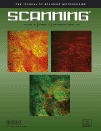Atomic Force Microscopy of Recombinant Adeno-associated Virus-2 Prepared by Centrifugation
Abstract
In order to decrease salt crystal formation, reduce the aggregation of viruses in atomic force microscopy (AFM) preparations and obtain an acceptable AFM image, the AFM sampling of viruses must be optimized. In this paper, centrifugal AFM sampling of recombinant adeno-associated virus-2 (rAAV-2) was used. The prepared rAAV-2 virus was imaged by AFM using the tapping mode in air. The results indicate that the rAAV-2 viruses prepared by centrifugal AFM sampling methods could be well imaged by AFM. The rAAV-2 viruses exhibited polymorphous particles in the AFM images. The preliminary off-line section analysis of the individual rAAV-2 virus particle indicated that the half-high widths of the large rAAV-2 particles ranged from 18 to 23 nm, while those of the small rAAV-2 particles ranged from 15 to 17 nm, which is almost in agreement with the results obtained by the off-line particle analysis of the rAAV-2 virus particles. Above all, the aggregation of different-sized rAAV-2 particles was directly imaged by AFM, which verifies the previous speculation that the large number (>∼31 nm) distribution of the mean diameter of rAAV-2 virus particles was probably caused by aggregation of rAAV-2 particles. SCANNING 29: 238-242, 2007. © 2007 Wiley Periodicals, Inc.




